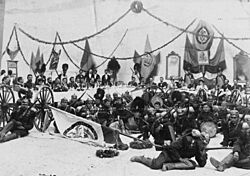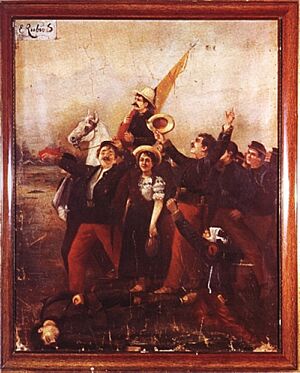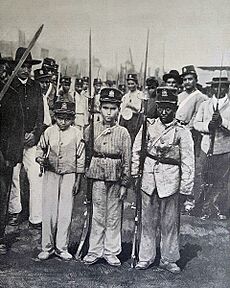Thousand Days' War facts for kids
Quick facts for kids Thousand Days' War |
|||||||
|---|---|---|---|---|---|---|---|
| Part of the Colombian Civil Wars | |||||||
 Government soldiers at a banquet, 1899. |
|||||||
|
|||||||
| Belligerents | |||||||
|
|||||||
| Commanders and leaders | |||||||
| Gabriel Vargas Santos Rafael Uribe Uribe Benjamín Herrera Justo Leónidas Durán Belisario Porras Barahona Lucas Caballero Barrera Manuel de Jesús Álvarez Reales Avelino Rosas † Victoriano Lorenzo † Zenón Figueredo † Aristóbulo Ibáñez † Ramón Marín Valdez Pedro Soler Martínez Paulo Emilio Bustamante Foción Soto Juan Francisco Gómez Pinzón † Benito Ulloa |
Manuel Antonio Sanclemente Roberto Urdaneta Gómez Alfredo Vásquez Cobo José María Campo Serrano Carlos Albán † Víctor Manuel Salazar Joaquín Fernando Vélez Jorge Holguín Mallarino Rafael Giraldo Viana Marceliano Vélez Barreneche |
||||||
| Strength | |||||||
| 5,000 (1899) 26,000 (1902) |
15,000 (1899) 50,000 (1901–1902) |
||||||
| Casualties and losses | |||||||
| 100,000-180,000 | |||||||
The Thousand Days' War (Guerra de los Mil Días) was a major civil war in Colombia. It lasted from October 17, 1899, to November 21, 1902. The war was mainly fought between the Liberal Party and the government. At first, the government was led by the National Party. Later, the Conservative Party took over the government.
This war was caused by a long disagreement over how Colombia should be governed. Some people wanted a federal system, where different regions had more power. Others wanted a centralized government, where the main government had most of the power. These ideas were supported by the Liberals, Conservatives, and Nationalists.
Tensions grew after the 1898 presidential election. On October 17, 1899, the Liberal Party officially started a rebellion in Santander. The fighting began on November 11, when Liberals tried to take over the city of Bucaramanga. The war ended three years later with the signing of two peace agreements: the Treaty of Neerlandia and the Treaty of Wisconsin.
The Conservatives won the war. This meant the Conservative Party stayed in power in Colombia for another 28 years. Colombia has remained a centralized country ever since.
The war also involved other countries like Ecuador and Venezuela. Groups from these countries, and from Guatemala, El Salvador, and Nicaragua, supported their favorite side in Colombia. The U.S. also got involved because they were interested in building the Panama Canal. They sent their navy to Panama (which was part of Colombia then) to protect their interests.
The Thousand Days' War was the deadliest war in Colombia's history. Between 100,000 and 180,000 people died. This was about 2.5% to 3.8% of the country's population at the time. The war caused huge problems for Colombia. It led to a weak economy, continued government instability, and the eventual loss of Panama in 1903.
Contents
Why the War Started
Throughout the 1800s, Colombia was often politically unstable. Two main political groups, the Conservatives and the Liberals, had very different ideas. Conservatives wanted a strong central government. Liberals wanted a federal system, giving more power to local regions.
After a civil war in 1885, the federal Constitution of Rionegro (from 1863) was replaced. A new constitution in 1886 created a more centralized government. This period was known as the "Regeneración" (Regeneration).
The Regeneración brought some peace, but it didn't solve all the disagreements. Tensions continued between different parts of the country. Also, President Manuel Antonio Sanclemente became ill and couldn't lead well. This created a power vacuum.
All these problems eventually led to open rebellion. On October 17, 1899, the Liberal Party in Santander announced their uprising. The fighting truly began on November 11 with the Battle of Bucaramanga.
Key Events of the War
The Liberal Uprising Begins
The Liberals had planned to start the war on October 20, 1899. However, some Liberal generals, like Paolo Emilio Villar, started early on October 17. Many Liberals were unsure, thinking they weren't ready or strong enough. Still, the rebellion began in Socorro, Santander. The rebels hoped for military help from Venezuela.
The Conservative government was also getting ready. They planned to send troops to Bucaramanga, the capital of Santander. But these troops never arrived. They refused to be paid with "tickets" because the government was in a bad economic state. No one expected the war to last three years and cause so much damage. Over time, the war spread across all of Colombia.
The Liberals faced early defeats. The Conservatives won the Battle of Magdalena River on October 24. However, the Conservatives also had their own problems. They were split into two groups: the Historical and National Conservatives. They tried to bring order by removing President Sanclemente. They replaced him with Jose Manuel Marroquin. In response, the Liberals chose Gabriel Vargas Santos as their presidential candidate.
Two major battles, Peralonso and Palonegro (both in Santander), caused a lot of destruction. At Peralonso, the Liberals won under the leadership of Rafael Uribe Uribe. But at Palonegro (May 26, 1900), the Conservatives stopped the Liberals in a very bloody fight.
The War Nears Its End
After the Battle of Palonegro, the Liberals split into two groups: those who wanted peace (pacifists) and those who wanted to keep fighting (warmongers). Some Conservatives also felt it was time to end the war. By this point, most of the fighting was happening in Panama and along the Caribbean Sea coast.
This decision helped prevent the war from becoming a bigger international conflict. Even though Venezuelan President Cipriano Castro supported the Liberals, Conservative troops managed to cut off Venezuelan aid. This happened on July 29, 1901, during the Battle of San Cristóbal.
President Castro of Venezuela pushed for the war to continue into 1902. In September 1901, he sent 1,200 Venezuelan soldiers, cannons, rifles, and a machine gun into Colombia. Many Liberal troops near the border were Venezuelans. During the Battle of Riohacha, Castro even sent a gunboat to block Conservative ships. But Colombian reinforcements arrived, leading to a Liberal-Venezuelan retreat and a Colombian victory.
Eventually, General Uribe realized the Liberals couldn't defeat the Conservatives. He decided to surrender, but he had some conditions.
Peace Treaties: Neerlandia and Wisconsin
The first peace agreement was signed at the Neerlandia plantation on October 24, 1902. Fighting had mostly stopped in Panama by mid-1902. Before that, there was a naval battle on January 20, 1902. The Liberal ship Admiral Padilla defeated the Lautaro, which was a Chilean ship lent to the Conservatives.
Later, the American navy arrived. The U.S. government, led by President Theodore Roosevelt, sent them to protect their future plans for the Panama Canal. The Liberals, led by General Benjamin Herrera, were then forced to surrender. The later killing of Victoriano Lorenzo is seen by indigenous Panamanians as the loss of their fight for land rights.
The final peace treaty was signed on the American battleship Wisconsin on November 21, 1902. The Liberals were represented by General Lucas Caballero Barrera and Colonel Eusebio A. Morales. The Conservatives were represented by General Víctor M. Salazar and General Alfredo Vázquez Cobo. Together, they signed the end of the war, bringing peace to Colombia.
Images for kids






